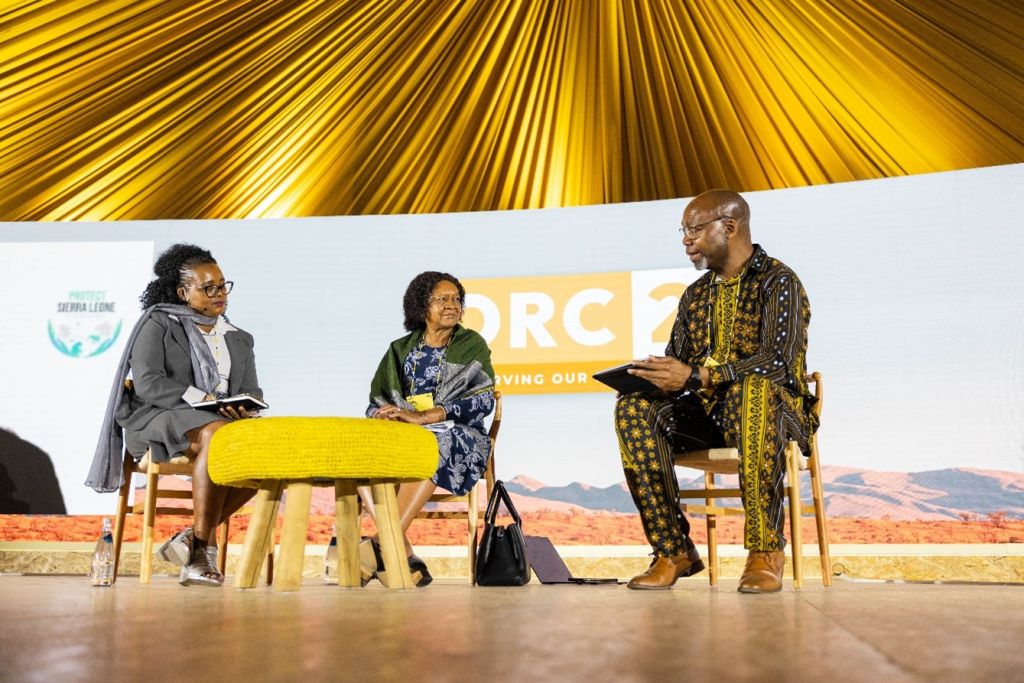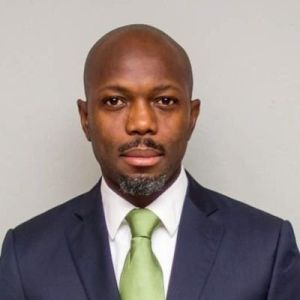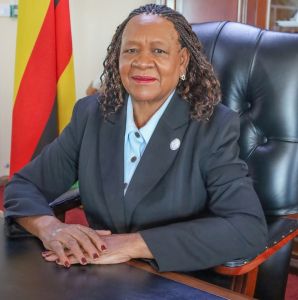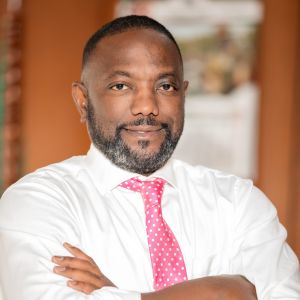Investing in nature: African ministers call for rethink on conservation funding
At a ministerial panel at this week’s Oppenheimer Research Conference, African environment and tourism leaders called for conservation funding to be seen not as charity but as essential investment in humanity’s future.

We need to change how we view public spending on nature and regard it as we do spending on things like bridges and roads: We must see it as a necessary investment in infrastructure, or rather as something even more important, because protecting natural assets is really about human survival.
“We should not be looking at funds for nature as charity. It isn’t. If our mindset changes from charity to this is something humanity needs and it is in our collective interest to fund it for current and future generations, we can start moving in the right path,” says Jiwoh Abdulai, Sierra Leone Minister of Environment and Climate.
Abdulai was speaking at a panel discussion at the Oppenheimer Research Conference in a Tipping Points webinar organised by Oppenheimer Generations Research and Conservation.
He pointed out that many of the natural assets of tropical countries, like his own with its rainforests, fall within national borders. But the vital ecological services they provided were shared by the planet. This was why Sierra Leone was pushing for improved funding for conservation from the global community.
“Thinking that private capital can come into conservation and solve conservation issues – it just hasn’t worked. If it was going to work, it would have by now; we’d have seen a flood of private money coming in,” said Sikhumba.

Joining him on the panel were Zambian Tourism Minister Rodney Sikumba; Zimbabwean Minister of Environment, Climate and Wildlife Evelyn Ndlovu; and Dr Patience Gandiwa, a director with the Zimbabwe Parks and Wildlife Management Authority.
Dr Buyani Zwane, a business leadership expert who sits on a number of public boards and committees, including the iSimangaliso Wetland Park Authority, chaired the talks.
The theme of the discussion was, “Alignment of interests: Transitioning from short-term philanthropy to permanent outcome-based capital through the reduction of frictional costs”.
funding for the future
Abdulai, who has a background in international finance and economics, said well-meaning people often designed conservation projects as charities, but if they were to be sustainable they must be thought of, if not as business, then with the discipline in mind that they needed to break even in the long run.
To this end, it was important that conservation initiatives received continued funding until they could stand on their own feet. Public funding would have to pave the path for private investment, with efforts made to reduce risk to attract private funders on a global scale, he said.
Efforts must also be made to ensure communities benefited more directly. This would help projects endure, said Abdulai.
Gandiwa, an ecologist with insider experience of transfrontier parks and their management, spoke about how Zimbabwe had come to realise the vulnerability of their conservation funding model, anchored as it was on tourism revenues.
The country was now exploring other ways, including drafting a biodiversity economy strategy, to fund conservation.

Ndlovu said conservation was “very expensive” and there was “no panacea or one-size-fits all” financing solution.
In neighbouring Zambia, as was the case elsewhere in Southern Africa, the Covid years choked tourism revenues which were vital to funding conservation. But Sikumba reported a strong recovery, with nearly 2.2-million visitors to his country in 2024, a surge of 35%.
The Zambian minister said they were well aware of the pressure tourism puts on natural environments, but felt this was balanced by the country’s commitment to conservation. He pointed out that one-third of the country’s land mass, 752 000 square kilometres, were protected through national parks, or game management areas.

“Philanthropy is good. Philanthropy is welcome,” said Sikumba, but with this funding the project ought in time to become self-sustaining, freeing donors to support other projects, perhaps in other African countries.
He spoke of Zambia’s 20 national parks and said that collaborative management projects with donors were now in place in the five biggest, including the country’s flagship Kafue National Park, with 80% of revenue reinvested in the parks and the balance returning to the national treasury.
He expected the collaborative management partners to reduce their pledges over the years as the parks become more sustainable financially.
nature at the heart
Tourism in Zambia was nature-based and this underscored the need to keep natural treasures like Mosi-oa-Tunya — aka Victoria Falls — pristine.
Resource allocation to conservation must follow community engagement. This included developing relations with traditional authorities, to ensure the people who live in or near natural assets benefited more directly, he said.
Asked about human-wildlife conflict in the context of funding, Sikumba spoke about how in Livingstone, the falls town where he was born grew up, elephants were not always the proverbial “gentle giants” he liked to think of them as, but “can be very damaging”.
This had prompted calls from hard-pressed locals for their extermination, which the minister was obliged to parry. “I say, ‘Look, these animals are the drawcard for tourism. There is no way we can start to kill these animals.’ And in any case, we are party to certain conventions… (preventing) a unilateral decision as to how we can deal with this particular matter.”
Ways must be found to educate people so they could co-exist with wildlife, said Skimumba. He added that in Zambia, with its growing, youthful human population, the scramble for land for agriculture and other uses meant people were encroaching on land intended to serve as wildlife corridors. Alternatives would have to be found.
Zwane wanted to know from the panelists why some international climate change and environment funding vehicles were “not fit for purpose”. What frictions prevented access to the funding vehicles? And what changes would they like to see in international funding so it could reach the places where it was needed most?
Ndlovu pointed out flaws in international donor funding: It was not discretionary. It came with strings attached. It was tied to specific projects; and had to be completed in a given time. Moreover, it demanded applicants submit rigorous proposals.
But writing proposals, typically to tight deadlines, was tough, she said, calling for capacity building to help African conservations better deal with the complexities involved. “We need a lot of training of our people to access funding,” she said.
Innovating for impact
Given these difficulties and the limits of tourism revenue, Zimbabwe (and other African countries) were devising alternative funding models, said Ndlovu. She mentioned a carbon credit registry that Zimbabwe had established and which was expected to “bring in a little bit of money”.
This would supplement government and donor money. Meanwhile Zimbabwe was working to attract private investment in its parks and this had now funded the renovation of national park accommodation.
Gandiwa said Zimbabwe and other African countries sometimes lacked the mechanisms to take advantage of new and existing climate and nature funds.
She said they would need to innovate to take advantage of funding using new tools like natural capital accounting and debt-for-nature swaps. These would let them unlock value in the country’s natural assets — to “match ambition with the requisite resources”.
Capital accounting is a measuring and reporting framework. It reveals the economic value of ecosystems and biodiversity. This information demonstrates the financial risks of environmental degradation and the potential returns of conservation, supporting investment.
Debt-for-nature swaps are financial agreements where a portion of a country’s foreign debt is cut in exchange for it committing to conservation and climate-related actions. Gandiwa mentioned Belize and other countries as benefiting from this form of funding. “Other countries have done well, so can we,” she said.
Addressing the question of frictional costs — expenses, often administrative and transactional that can be hard to account for and yet eat into investments — Abdulai said projects and their financing must be streamlined, with better governance and access.
“We should try to ensure that as much of the funding goes to communities, so we have value for money, and we can roll out projects which can be sustained over the long run,” he said.
Sikumba said these costs arose on both the donor and recipient government side, resulting sometimes in only a fraction of the original funding money reaching the intended landscape.
He called for greater transparency.
“Where is the money actually going? This is where you find consultant after consultant,” he said, describing how loads of reports and glossy brochures are produced on the donor side of the funding equation.
Cutting red tape
At the same time, government bureaucracy proliferated. Workshops seemed to follow workshops, even though a necessary concept document had already been approved, and the officials involved should know what to do.
“But then why do you create another committee? You never create a committee to kill a snake,” he quipped.
Frictional cost could certainly be reduced, although perhaps not entirely avoided, said Sikumba.
He suggested a system be created to help see funding applications through to conclusion, with sharing of skills and best practice documentation among African countries.
“So it’s very, very important that we see how we can speak to each other within the African continent. After all, we’ve got the largest natural resources in the world today. So based on that, there has to be more collaboration.”
This story was produced with support from Jive Media Africa, science communication partner to Oppenheimer Generations Research and Conservation (OGRC).
Author
- Healing the planet from the ground up - December 12, 2025
- Investing in nature: African ministers call for rethink on conservation funding - October 17, 2025
- From ponds to power plays: South African scientist tackles invasive plants with game-changing research - October 16, 2025


